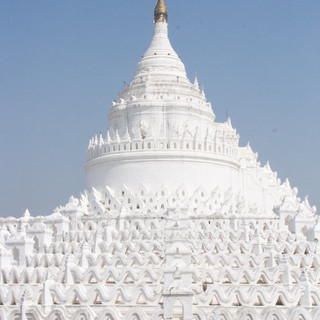MinGun, Myanmar
Photography by Lucas Stoffel can be licensed on Shutterstock and Getty Images

The Unfinished Stupa by Luke Stoffel - Fine art prints available on Etsy.
Mingun, Myanmar and the Gigantic unfinished stupa and the world's 2nd largest bell.
Nice pile of bricks you’ve got here. The Mingun Pahtodawgyi is a nice pile of bricks indeed and holds the record for being the biggest pile of bricks in the world.
Intended to be a 500 foot high stupa, a mound housing Buddhist relics, the Pahtodawgyi remains unfinished to this day but is still an awe-inspiring structure. Measuring 450 by 450 feet and 172 feet high, it dwarfs the surrounding area, and would easily have rivaled the size of the Great Pyramid of Giza had King Bodawpaya finished its construction.
Construction began in 1790, using mostly slave labor, and causing a massive drain on resources and manpower in the area. The project was widely unpopular during its time, which some suspect caused its cessation.

The Unfinished Stupa by Luke Stoffel - Fine art prints available on Etsy.
King Bodawpaya was a superstitious man and during the construction, it was prophesied that the completion of the great stupa would cause his death or the destruction of the country. Worried about maintaining his empire, the king slowed progress on the stupa. When he died, construction was abandoned completely.
Despite not completing the stupa, construction on an accompanying bell was finished, and was similarly grand in size. The finished bell weighed over 200,000 pounds and is 12 feet high. The massive bell can be rung by striking the outside since it has no internal ringing mechanism.
Since the early 19th century, the stupa has become increasingly decrepit. An earthquake in 1839 left giant cracks along the face of the stupa, and wear and tear have led it to become almost natural looking. Without the bright white entrance, visitors could easily mistake the stupa for a large earthen mound, or simply a pile of bricks.
Next door is the beautiful white pagoda. One of Min Gun's finest attractions:
The White Pagoda by Luke Stoffel - Fine art prints available on Etsy.




































